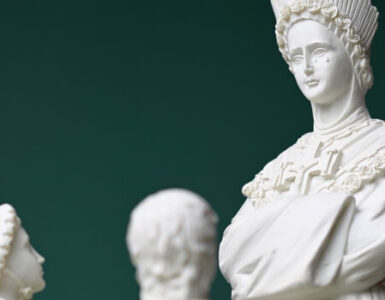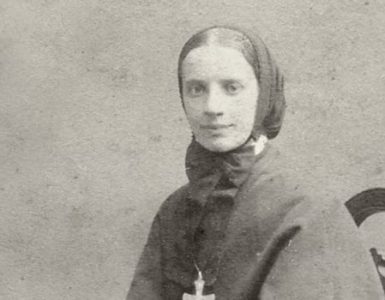Author’s Note: This is the third article of my series on Finding Faith in Fandoms. This article contains spoilers for Frozen.
On first viewing, Disney’s Frozen seems like simply a fun adventure story. But the more time that has passed since its 2013 release, the more I’ve realized how profound its themes are. Looking at its symbols and archetypes, it is an excellent example of royal characters’ relationships impacting their community and natural environment. It clearly follows the salvation story pattern and conveys some of the most Christian themes in any Disney film.
Loosely based on Hans Christian Andersen’s “The Snow Queen,” Frozen revolves around two sisters, Elsa and Anna, princesses of the fictional Scandinavian kingdom of Arendelle. Though they have loving parents and share a deep bond as children, the royal family breaks down over time. Elsa accidentally hurts Anna with her magical ice powers, and is warned that they may create danger in the future. This prompts the parents to keep the sisters apart from each other and hide them from the rest of the kingdom until Elsa learns to control her powers. The untimely death of the king and queen leaves the sisters and their kingdom leaderless—and vulnerable to those who would take advantage of them. When the sisters’ relationship is further fractured by a disagreement, Elsa loses control of her magic and causes an unseasonal winter to fall upon the kingdom. The two sisters must heal their relationship in order to restore the natural cycle of seasons in their home.
Innocence and Isolation
Elsa’s ice powers may symbolize many things, but for this reflection I’ll focus on just one: human beings’ free will and tendency toward sin, whether actual or perceived.
Elsa’s powers start out as a source of joy, but she learns at a young age that they can cause harm to her loved ones if she is not careful with them. From then on, she looks upon her powers, and in turn herself, with fear, shame, and a desperate desire for control. Elsa and her parents think the best way for her to avoid hurting others is to isolate herself and suppress her powers.
This is similar to the entry of sin into the world. When Adam and Eve ate the fruit of the Tree of Knowledge of Good and Evil, they became aware of the capacity for wrongdoing. Adam and Eve responded to this loss of innocence by clothing themselves and hiding from God; Elsa responds by wearing gloves and hiding from everyone, even those she loves most.
If Elsa’s struggle for self-control is similar to human beings’ struggle against sin, her seclusion is like trying to avoid all opportunities to sin. This may be appropriate for some situations, like trying to overcome an addiction or bad habit by avoiding particular temptations. But isolation does not strengthen one’s conscience. The virtuous life is best supported by relationships with others striving for the same goal. This is why recovery groups exist for people struggling with addictions, providing them with encouragement and accountability. But Elsa’s powers are a secret that she believes she must carry alone. This creates a cycle of fear and shame that only worsens as her powers grow.
Love Personified
Olaf, the snowman built by Elsa and Anna in childhood who later gains sentience, is more than just a cute sidekick providing comic relief. He is also a symbol of the sisters’ love for each other.
There is a trinitarian dynamic between these three characters. The sisters’ love is creative, and eventually takes on a life of its own, becoming a distinct being. This is similar to the Holy Spirit proceeding from the love between the Father and the Son. Olaf later accompanies Anna on her quest to find and reconcile with Elsa, similar to the Holy Spirit accompanying Christ during His earthly ministry.
The song “Do You Wanna Build a Snowman” reveals Anna’s persistence in pursuing a relationship with her sister. Despite being repeatedly ignored and rejected, Anna continues to knock at her sister’s door, like Jesus who “stand[s] at the door and knock[s]” (Revelation 3:20). When Anna asks Elsa if she wants to “build a snowman,” she is really asking, “Do you want to have a relationship? Do you want to collaborate? Do you want to make something beautiful and full of life?”
When Anna is at her lowest point, Olaf reveals the true meaning of love: “putting someone else’s needs before yours.” This is very similar to St. Thomas Aquinas’s definition! Love is a desire for and commitment to another’s good; that is the lesson Anna both learns and demonstrates over the course of the film.
“An Act of True Love”
Despite the previous rejections and present risks, Anna enters Elsa’s ice palace in the mountains and attempts to persuade her to come home. Olaf is also there, a reminder of their childhood relationship, and Anna tells Elsa that they can be that close again. This is like God calling the Israelites to remember their covenant with Him even after they turn away.
But Elsa is still haunted by the memory of her sister being hurt due to her own lack of self-control. She is further devastated when she learns that she unintentionally “set off an eternal winter.” Her rising emotions trigger her ice magic, and she accidentally strikes Anna’s heart with ice, causing her to slowly freeze.
Anna is told that only “an act of true love” can save her from freezing completely. She initially believes this must come in the form of a kiss from Hans, the charismatic prince who proposed to her earlier in the film. But Hans turns out to be analogous with Satan in this story: he is the deceiver, seducer, and accuser, intent on destroying the heirs and taking over the kingdom.
Anna steps fully into the role of Christ-figure at the climax of the story. Hans betrays Anna, leaves her to freeze to death, and intends to execute Elsa and make himself king. He finds Elsa and accuses her of killing her sister, which she is all too ready to believe. At the same time, Anna sees Kristoff, the ice harvester who genuinely loves her and could potentially save her from freezing. But instead of seeking her own salvation, Anna steps between Elsa and her accuser, just like Jesus dying to save us from Satan. Anna succumbs to her frozen heart in that moment, a “death” that shatters Hans’ sword and saves Elsa’s life.
This apparent death, however, is reversed by its nature as “an act of true love,” the one thing that was said could thaw a frozen heart. When Elsa asks Anna how she could sacrifice herself like that, Anna simply replies, “I love you.”
With Anna and Olaf’s help, Elsa finally realizes that the way to temper her powers is not through fear and isolation, but love and connection. As she opens herself to love, she is able to melt the snow and ice, restoring summer to Arendelle. Elsa’s journey is about being open to love, while Anna’s journey involves learning what love is. They essentially learn what 1 John 4:18 says: “There is no fear in love; perfect love drives out all fear.”
Photo by Kacper Szczechla on Unsplash










